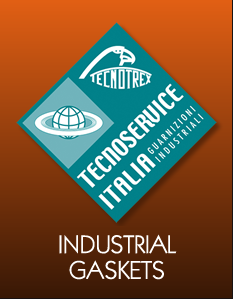The requirements of a gasket are many, such as a good elastic return, the ability to maintain its properties over time, etc., in addition to its chemical and physical compatibility with the process fluid.
In the light of observations made we can summarize below the basic parameters for choosing the type of seal:
• Temperature and pressure of fluid
• Chemical nature of the process fluid.
• Mechanical load on the gasket
To meet all of these requirements, different types of gaskets were developed according to different working conditions, which can be divided into three basic groups:
• Flat gaskets
• Semi-metallic gaskets
• Metallic gaskets
The mechanical features and the pressure level of each category vary widely depending on the type of material and different arrangements of production used.
Flat Gaskets
Flat gaskets are made with both composite materials and mono-produced sheet materials and are adapted for a wide range of applications;
- average pressure – high, medium and low
- temperatures up to 600 °C
- compatibility with any type of acid and base, even at high concentration
- where required, maximum deformations under load.
Among the production materials, we would like to point out the asbestos-free compressed fibres with a base of Aramid fibre, graphite, armoured smooth graphite and armoured perforated graphite, rubber and PTFE.
Thanks to our cutting edge technology, experience and knowledge of materials, we are able to cut virtually any material and obtain gaskets designed according to the specifications of the end user, or based on a sample.
We can obtain simple or complex shapes, gaskets with one or more crosspieces. In the case of particularly large parts we able to provide the part divided like a puzzle. .
Keep in mind, however, that parts with containable dimensions in a 1500 X 1500 slab can be delivered in one piece. We are also able to accept designs from our clients in DXF format for direct production of a part.
Semi-metallic Gaskets
Semi-metallic gaskets are made in metallic and non-metallic materials, which give the gasket resistance and elasticity. Adapted for high temperature and pressure. The types are varied.
Plastic smooth gaskets with metallic reinforcement on the external and internal burners, metal-plastic gaskets, spiral wound gaskets, and lenticular and lamellar gaskets.
Metallic Gaskets
These gaskets can be composed of just one metal or a combination of metals, and they present a certain variability of shapes and sizes. They are suitable for systems with very high pressure and temperatures. Belonging to this group are lenticular gaskets, oval and octagonal Joint rings, Rx, Bx, and ribbed gaskets.
Spiral wound Gaskets
These are constructed winding a tape of ferrous material that is pre-formed (generally V) together with a filler. The winding of the two elements continues until the desired diameter is reached. Generally the shape is circular but it can also be oval with or without crosses according to the specific needs of the customer. These gaskets are quite versatile, with a strong adaptation to the different working conditions of the sealing system. In fact, they have optimal elastic return compared to metallic gaskets. The spiral wound gaskets therefore pose as a bridge between the smooth plastic gaskets and the metallic gaskets. These represent a strong innovation in that they allow in many cases for substitution of the metallic gaskets, with the advantage of having reduced tightening loads.
|
